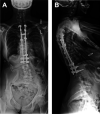Orthopaedic Management of Loeys-Dietz Syndrome: A Systematic Review
- PMID: 34779796
- PMCID: PMC8594655
- DOI: 10.5435/JAAOSGlobal-D-21-00087
Orthopaedic Management of Loeys-Dietz Syndrome: A Systematic Review
Abstract
Introduction: Loeys-Dietz syndrome (LDS) is an autosomal dominant connective tissue disorder associated with aortic aneurysm/dissection in children. However, LDS may also present with a host of orthopaedic conditions. This study aimed to elucidate the management of orthopaedic conditions and associated outcomes in patients with LDS.
Methods: PubMed, Ovid MEDLINE, and Cochrane Library were systematically searched for primary articles regarding the management of orthopaedic conditions in patients with LDS. The goals and findings of each included study were described. Data regarding demographics, conditions studied, treatment modalities, and outcomes were extracted and analyzed.
Results: Three hundred sixty-two unique articles were retrieved, 13 of which were included, with 4 retrospective cohort studies and 9 case reports representing 435 patients. In total, 19.8% of patients presenting with orthopaedic conditions received surgical treatment;54.3% of them experienced adverse outcomes, and 44.4% required revision surgery. The mean age at surgery was 9.0 ± 2.1 years.
Conclusion: Patients with LDS may require early surgical intervention for a variety of orthopaedic conditions and may be at an increased risk for surgical complications. The current LDS literature is primarily focused on spinal conditions with a relative paucity of data on the management of hip deformity, joint subluxation, clubfoot, and trauma. Additional research is required regarding orthopaedic management for this unique population.
Copyright © 2021 The Authors. Published by Wolters Kluwer Health, Inc. on behalf of the American Academy of Orthopaedic Surgeons.
Conflict of interest statement
Dr. M.A. Seeley or an immediate family member has received personal fees from Orthopediatrics, outside the submitted work. None of the following authors or any immediate family member has received anything of value from or has stock or stock options held in a commercial company or institution related directly or indirectly to the subject of this article: Mr. Lynch, Ms. Patel, and Dr. A.H. Seeley.
Figures






References
-
- Loeys BL, Chen J, Neptune ER, et al. : A syndrome of altered cardiovascular, craniofacial, neurocognitive and skeletal development caused by mutations in TGFBR1 or TGFBR2. Nat Genet 2005;37:275-281. - PubMed
-
- Loeys BL, Dietz HC: Loeys-Dietz syndrome, in Adam MP, Ardinger HH, Pagon RA, et al., eds: GeneReviews®. Seattle, WA, University of Washington, 2008.
-
- Loeys BL, Schwarze U, Holm T, et al. : Aneurysm syndromes caused by mutations in the TGF-beta receptor. N Engl J Med 2006;355:788-798. - PubMed
Publication types
MeSH terms
LinkOut - more resources
Full Text Sources

